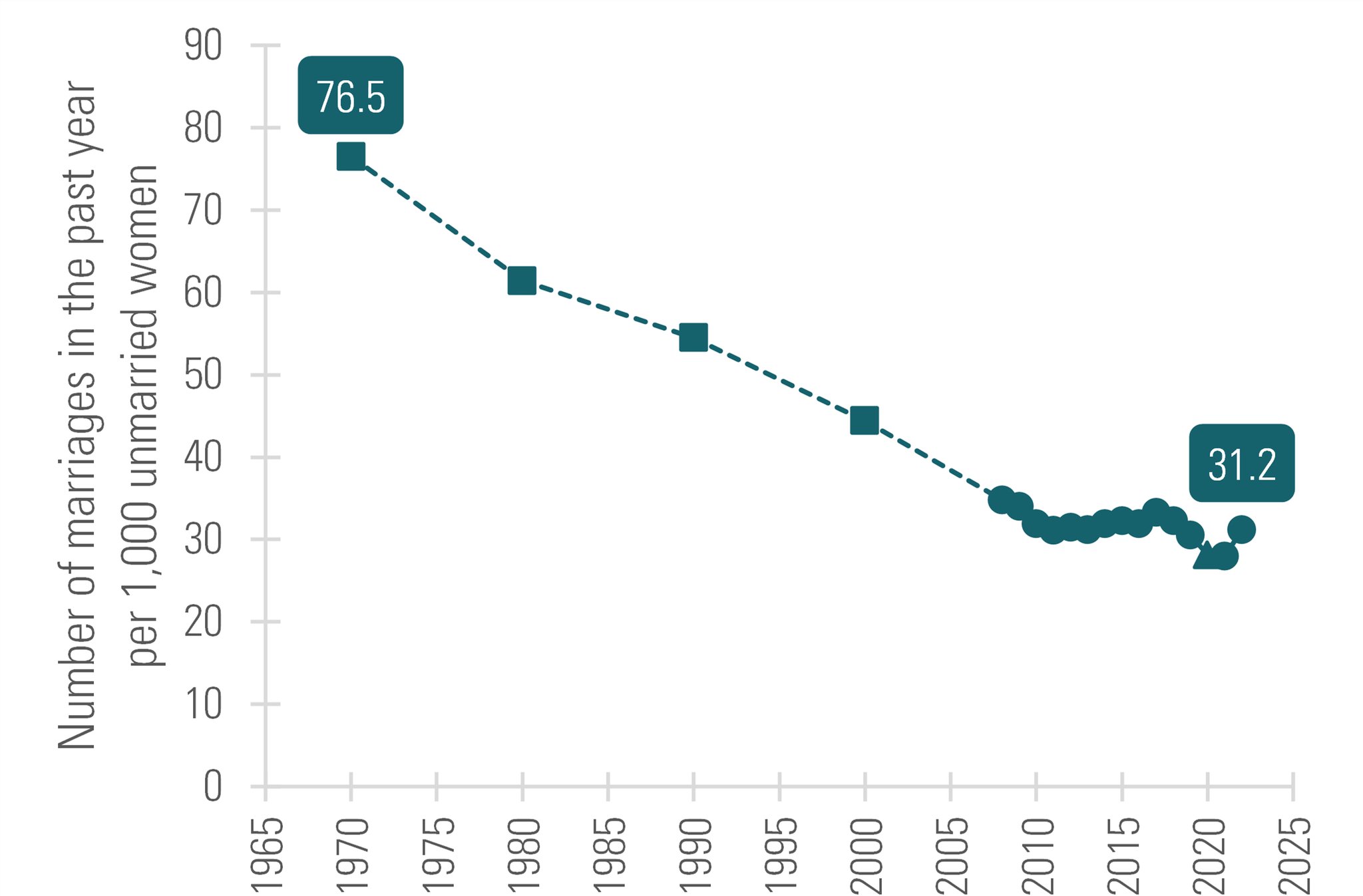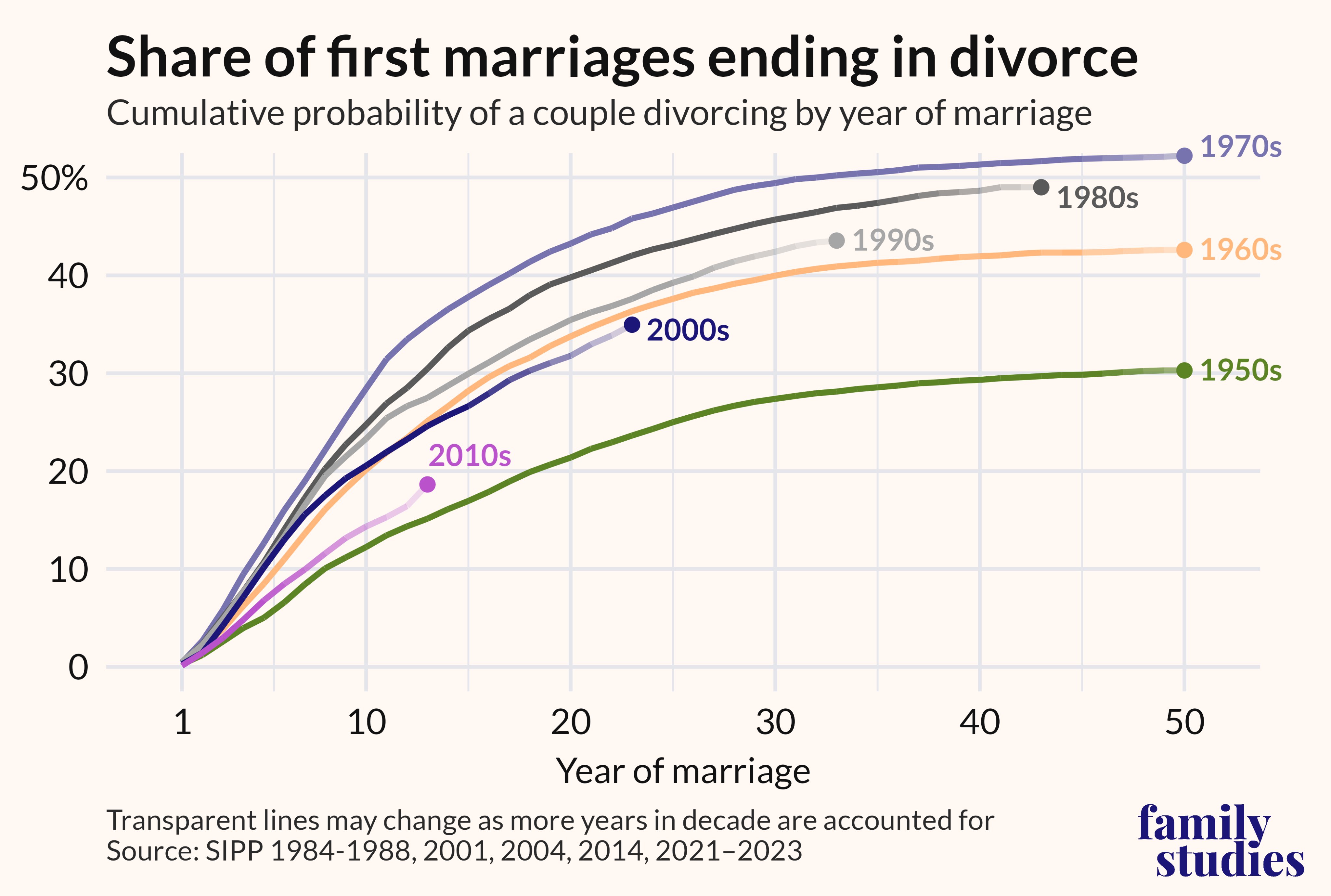This week we are discussing what is going on with modern dating, marriage, and divorce.
In our last two posts (here and here) we discussed getting married at a young age (between the ages of 18 and 25). We pointed out that there was little practical benefit to delaying marriage and that delaying marriage comes with significant risks of its own. We also pointed out that not everyone’s risk is identical: the more intelligent you are (up to a point), the more likely you are to have a successful marriage. With these in mind, we’re now going to examine the state of marriage, and how it has changed over time.
Probability of Divorce
There was a time when 50% of first time marriages ended in divorce. What most people do not know is that this was restricted to the cohort of marriages from the height of the no-fault divorce era: the 70s and 80s. The reality is that divorce rates have been falling ever since their height. If you married in the 2000s, the probability that you will divorce is actually lower than if you got married in the midst of the Sexual Revolution. And, if you married in the 2010s, you are only a little bit more likely to divorce than the pre-Revolution 1950s. If this trend holds, people getting married in the 2020s will have the lowest divorce rates in nearly 80 years. Divorce rates among the young are essentially at the lowest they have ever been for anyone currently alive.
In today’s marriage environment, roughly 85% to 90% of first time married couples will still be married after a decade of marriage. All else equal, the average first time marriage today has only a 30% lifetime chance of divorce.
You’ve all heard the Manosphere bros, feminist bloggers, & media midwits complain that ‘50% of marriages end in divorce’.
Yeah, if you got married in the 1970s.
But if you got married in the 2010s, over 85% of marriages lasted at least 10 years… and they’re on track to have a divorce rate no higher than people who got married in the 1950s.
Depending on who you read, you’d have no idea that marriage was doing so well and that divorce risk was falling and at a relative all-time low.
There must be a catch, right? So what is it?
Probability of Marriage
You might think that divorce rates are down because:
- “people are cohabitating”
- “people are waiting to get married”
We have already seen in our last two articles that waiting to get married results in, at best, a marginal net reduction in divorce risk. The tradeoff the much larger decrease in the odds to marry at all. So waiting to get married is mostly irrelevant and a bad idea. If you have the chance to marry, it may well be your only opportunity to do so. Don’t let divorce risk dissuade you. The sooner a man prioritizes marriage the better.
But what about cohabitating? “Trying before you buy” is well-known to dramatically increase divorce risk. If you exclude married people who have cohabitated prior to marriage, the divorce risk for married people plummets even further! Do you want to minimize your divorce risk? Try this one simple trick: don’t have sex. This is especially effective, because if you get dumped because you won’t have sex, you will have much more likely dodged the divorce bullet. Similarly, don’t ever date a non-virgin.
The reality is that the population is segmenting between those who marry and those who do not. Fewer people are getting married…

…and those who do get married are predisposed to be better at it. The fact of the matter is that people who are prone to divorce are not getting married, leaving marriage to the “elite.” Remember when I said this in part 1?
Smart people should get married and everyone else should not.
In modern marriage, what this actually works out to is this:
Smart people will get married and everyone else won’t have much chance.
The fact is, many of the people having trouble getting married are the kind of people who would have been getting divorced in the past. The marriage market has corrected for the imbalance by excluding those who are “unfit” for marriage and those who would have married them. These days, most of the people who would have been destined divorce in the past are now cohabitating or engaging in promiscuous short-term relationships—activities that only show why they are being excluded from marriage—or else they are celibate.
Divorce risk has been exchanged for marriage risk. Those of us still writing about divorce risk are probably old timers who are still living under the old paradigm. Divorce just isn’t the massive problem quite like it once was. The marriage marketplace has found a way to correct the problem.

